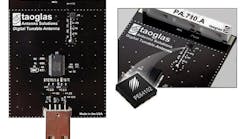A dynamically tunable Long-Term-Evolution (LTE) antenna solution has emerged to provide increased flexibility to the machine-to-machine (M2M) industry. This development combines an embedded surface-mount, ceramic, planar inverted F-antenna (PIFA) from Taoglas USA, Inc. with a digitally tunable capacitor (DTC) from Peregrine Semiconductor Corp. Taoglas’ Warrior PA.710.A PIFA and Peregrine’s PE64102 DuNE DTC, integrated together on one board, give M2M devices the capability to reach wide bandwidths and meet high-performance requirements within third- and fourth-generation (3G/4G) antenna space parameters (see figure). This solution also can dynamically change the antenna’s frequency band “on the fly” to match a radio module’s cellular band.
The digitally tunable Warrior PA.710.A antenna from Taoglas tackles lower frequencies, such as 700 MHz, without need of a large physical structure. Thus, it gives designers the opportunity to reduce product size. Moreover, the antenna can be “re-tuned” whenever it’s impacted by (for instance) a battery, enclosure, or liquid-crystal display (LCD). Antenna frequency can be adjusted for each specific location, such as during a drive across multiple locations or when a device moves between different countries.
Dynamically tuning the antenna with Peregrine’s DuNE DTC generates support for multiple bands while optimizing RF performance. This is particularly important in the M2M market. M2M wireless devices now have to support a subset of more than 40 frequency bands, and they must adapt “in the field” to connect to the strongest signal.
